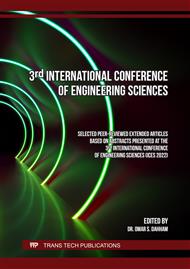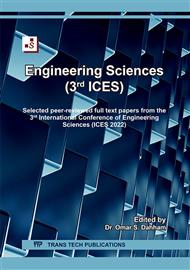[1]
API (American Petroleum Institute) (2002) API Specification 10A Specifications for Cementing and Materials for Well https://doi.org/Broni-Bediako, E., Joel, O. F. and Ofori-Sarpong, G. (2015), "Evaluation of the Performance of Local Cements with Imported Class 'G' Cement for Oil Well Cementing Operations in Ghana", Ghana Mining Journal, Vol. 15, No. 1, pp.78-84.
DOI: 10.4172/2157-7463.1000233
Google Scholar
[2]
Al-Martini S (2008) Investigation on Rheology of Cement Paste and Concrete at High Temperature. PhD thesis, The University of Western Ontario, Canada. https://doi.org/ Al-Martini, S., and Nehdi, M. (2007), "Effect of Chemical Admixtures on Rheology of Cement Paste at High Temperature", Journal ofASTM International, 4(3), 1-17.
DOI: 10.1520/jai100554
Google Scholar
[3]
ANSI/API (American National Standards Institute/American Petroleum Institute) (2005) ANSI/API RP 10B-2 Recommended Practice for Testing Well Cements, 1st edn. American Petroleum Institute, Washington DC, USA.Cementing, 23rd edn. p.58. American Petroleum Institute, Washington DC, USA.
DOI: 10.1002/0471740039.vec0153
Google Scholar
[4]
Guillot D (2006) Rheology of well cement slurries. In Well Cementing (Nelson EB and Guillot D (eds)). Schlumberger,Texas, p.93–142.
DOI: 10.1016/s0376-7361(09)70302-4
Google Scholar
[5]
H. Taylor, Cement Chemistry, seconded., Thomas Telford, London, 1997 https://www.icevirtuallibrary.com/doi/pdf/
DOI: 10.1680/cc.25929.fm
Google Scholar
[6]
P. Munjal, K. K. Hau, and C. C. H. Arthur, "Effect of GGBS and curing conditions on strength and microstructure properties of oil well cement slurry," J. Build. Eng., vol. 40, p.102331, 2021.
DOI: 10.1016/j.jobe.2021.102331
Google Scholar
[7]
A. Shahriar and M. L. Nehdi, "Rheological properties of oil well cement slurries," Proc. Inst. Civ. Eng. Mater., vol. 165, no. 1, p.25–44, 2012. https://www.icevirtuallibrary.com/doi/abs/
DOI: 10.1680/coma.2012.165.1.25
Google Scholar
[8]
U. States, Oil Black Gold. Texas Tea, 2020, p.1–17
DOI: 10.1016/j.upstre.2020.100015
Google Scholar
[9]
J. Jincai, Applied Petroleum Geomechanics, Gulf Profession al Publishing , 2019
DOI: 10.3389/feart.2022.846863
Google Scholar
[10]
B.F. Mallory , D .N. Cargo, Physical Geology , McGraw - Hill,19 79 . https://www.tandfonline.com/doi/abs/
DOI: 10.5408/0022-1368-35.1.22
Google Scholar
[11]
Yahia A and Khayat KH (2001) Analytical models for estimating yield stress of high performance pseudoplastic grout. Cement and Concrete Research 31(5): 731–738.
DOI: 10.1016/s0008-8846(01)00476-8
Google Scholar
[12]
Nehdi M and Rahman MA (2004) Estimating rheological properties of cement pastes using various rheological models for different test geometry, gap and surface friction. Cement and Concrete Research 34(11): 1993–2007.
DOI: 10.1016/j.cemconres.2004.02.020
Google Scholar
[13]
Standard Specification for Slag Cement for Use in Concrete and Mortars C989/C989M-18a-2018-ASTM International
DOI: 10.1520/C0989_C0989M-17
Google Scholar
[14]
A. Bouaziz, R. Hamzaoui, S. Guessasma, R. Lakhal , D. Achoura, N. Leklou, Efficiency of high energy over conventional milling of granulated blast furnace slag powder to improve mechanical performance of slag cement paste, Powder Techno 308 ( 2017 )37–46, https://doi.org/10.1016 / j. powtec . 2016 .12.014
DOI: 10.1016/j.powtec.2016.12.014
Google Scholar
[15]
I. H. S. Wild , J. M. Kinuthia , R.B.R., Effect s of ground granulated blast furnace slag (GGBS) on the strength and swelling properties of li me - stabilized kaolin it e in the presence of sulphates , Clay Mine r. 31(1996 ) 423 – 433 , https://doi.org/ 10 .1180 / clay min. 1996 . 031. 3.12 .
DOI: 10.1180/claymin.1996.031.3.12
Google Scholar
[16]
O. Eren, Strength development of concrete s with ordinary Portland cement , slag or fly ash cured at different temperatures , Mater. Struct. Constr. 35 ( 2002 )536 – 540, https://doi.org/10 .1007/ BF0248 31 21
DOI: 10.1617/13873
Google Scholar
[17]
P. Z. Wang, R. Trettin, V. Rudert, Effect of fineness an d particle size distribution of granulated blast - furnace slag on the hydraulic re activity in cement system s, Adv. Cement Res.17(2005) 161 – 166, https://doi.org/10.16 80 / adcr.2005 . 17. 4.161 .
DOI: 10.1680/adcr.2005.17.4.161
Google Scholar
[18]
A. Bougaa, C. Lynsdale, N. B. Milestone , Reactivity and performance of blast furnace slags of differing origin, Cement Concr. Compos . 32( 2010 ) 319 – 324 , https://doi.org/10.1016 /j.cemconcomp . 2009 .12 .00 2
DOI: 10.1016/j.cemconcomp.2009.12.002
Google Scholar
[19]
D.T. Mueller , G.DiLull o, J. Hi bbeler, P. Kelly , Port land cement - blast furnace slag blends in oil well cement in g applications , Proc. - SP E An nu . Tech. Conf. Ex hi b. Delta ( 1995 ) 659 – 662, https://doi.org/10.2523 /3051 3 -ms .
DOI: 10.2118/30513-ms
Google Scholar
[20]
ASTM (American Society for Testing and Materials) (2008) C494:nStandard specification for chemical admixtures for concrete. ASTM, West Conshohocken, PA, USA. https://doi.org/
DOI: 10.14359/51683709
Google Scholar
[21]
ASTM C 1437, 2001. Standard test method for flow of hydraulic cement mortar. Annual Book of ASTM Standards, vol. 04.01
DOI: 10.1016/j.conbuildmat.2008.09.006
Google Scholar
[22]
ASTM C 109/C 109M-05, Standard test method for compressive strength of hydraulic cement mortars (using 2-in. or [50-mm] cube specimens). 2005, ASTM Int
DOI: 10.1520/c0109_c0109m-13
Google Scholar
[23]
E. B. Nelson and D. J. Guillot, "Rheology and Flow of Well Cement Slurries," Well Cem., p.93–142, 2006
DOI: 10.1016/S0376-7361(09)70302-4
Google Scholar
[24]
A.-G. Olabi and A. Grunwald, "Design and application of magneto-rheological fluid," Mater. Des., vol. 28, no. 10, p.2658–2664, (2007)
DOI: 10.1016/j.matdes.2006.10.009
Google Scholar
[25]
Lu, Y.; Ma, H.; Li, Z. Ultrasonic monitoring of the early-age hydration of mineral admixtures incorporated concrete using cement-based piezoelectric composite sensors. J. Intell. Mater. Syst. Struct. 2014, 26, 280–291
DOI: 10.1177/1045389x14525488
Google Scholar
[26]
Robeyst, N.; Gruyaert, E.; Grosse, C.U.; de Belie, N. Monitoring the setting of concrete containing blast-furnace slag by measuring the ultrasonic p-wave velocity. Cem. Concr. Res. 2008, 2008, 38, 1169–1176
DOI: 10.1016/j.cemconres.2008.04.006
Google Scholar



